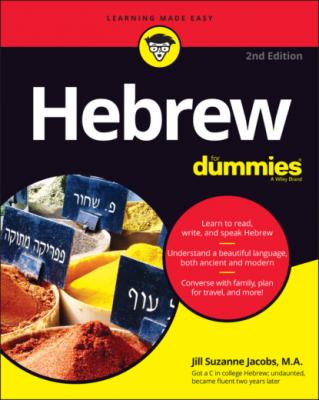Hebrew For Dummies. Jill Suzanne Jacobs
Читать онлайн.| Название | Hebrew For Dummies |
|---|---|
| Автор произведения | Jill Suzanne Jacobs |
| Жанр | Иностранные языки |
| Серия | |
| Издательство | Иностранные языки |
| Год выпуска | 0 |
| isbn | 9781119862048 |
Note: In this table, I used the letter א (aleph) so you could see how the vowels look when they’re attached to a consanant. (The vowels are the little squiggles and dots around the א.) Unlike in English, Hebrew vowels can never be written alone; they’re always attached to a consonant.
Table 1-7 shows the short vowels.
TABLE 1-7 The Short Vowels
| Name of the Vowel | Pronunciation | In Hebrew | The Sound It Makes |
|---|---|---|---|
| Herik Haser | ḥee-reekḥah-sehr | אִ | Makes an Ee sound as in see |
| Kamatz Katan | kah-mahtz kah-tahn | אׇ | Makes an O sound as in more |
| Kubutz | koo-bootz | אֻ | Makes an Oo sound as in mood |
| Patach | pah-tahḥ | אַ | Makes an Ah sound as in saw |
| Segol | seh-gohl | אֶ | Makes an Eh sound as in end |
Note: In this table, I used the letter א (aleph) so you could see how the vowels look when they’re attached to a consanant. (The vowels are the little squiggles and dots around the א.)
Sometimes, the Kamatz Patah, Kamatz Katan, or the Segol is paired with a Shvah. This pairing doesn’t change the pronunciation.
Introducing the Shvah
Shvah Na (shvah nah), which opens a syllable
Shvah Nach (shvah nahḥ), which closes a syllable
Shvah Merahef (shvah mehr-rah-ḥehf ), known as the flying shvah, which results from two Shvah Nas being next to each other in a word
The Shvahs don’t make their own sound but are essentially placeholders for the consonant above them. The Shvah Naḥ, however, holds the sound a little bit longer. You can tell a Shvah Naḥ because it usually comes in the middle or at the end of a word. A Shvah Na is at the beginning of a word or syllable
Doing it with a Dagesh
The little dot that you see in the middle of letters is called a Dagesh. Most of the time, this dot doesn’t change the pronunciation of the consonant except for three letters. I discuss this point later in this section.
Hebrew has two types of D’geshim (duh-gehsh-eem; the plural form of Dagesh):
Dagesh Kal (dah-gehsh kahl): Appears at the beginning of all words and at the beginning of all syllables in the following letters: בּ (Bet), גּ (Gimmel), דּ (Dalet), כּ (Kaf), פּ (Pey), and תּ (Tav).
Dagesh ḥazak (dah-gehsh ḥah-zahk): Appears after the word the, which in Hebrew is a prefix consisting of the letter Hey and the vowel Patach below it.
Don’t get too hung up on this distinction, because all D’geshim look the same!
HEBREW AS THE HOLY TONGUE — DON’T BITE IT
Judaism has always regarded Hebrew as a sacred language. Hebrew is often referred to as לְשׁוֹן הַקֹּדֶשׁ (le-shohn hah-koh-desh; the Holy Tongue), and even the Hebrew word for letter, אוֹת (oht), means “sign” or “wonder.” In fact, during the period of Hebrew’s revival as a spoken language, some people objected, saying that Hebrew was simply too sacred for saying things like “Take out the garbage.”
Also, all Hebrew letters have numeric value. A particular form of Jewish numerology called גִּמַּהְרִיָּה (gee-meht-ree-yah) plays on the words’ numeric values. Both the Hebrew word for wine (יַיִן;yah-yeen) and secret (סוֹד;sohd) have the same numerical value. The Talmud has a saying, “When the wine goes in, secrets come out!” Other Jewish sacred writings claim that the Hebrew letters are the manifestation of divine energy patterns and even that the universe’s DNA is composed of Hebrew letters.
A 13th-century mystic, Rabbi Abraham Abulafia, created a form
